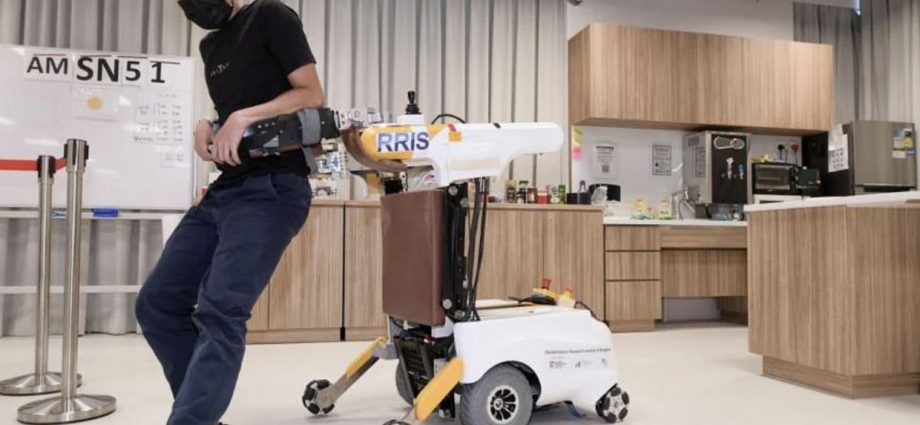
SINGAPORE: A wearable assistive robot that can detect and prevent falls especially among the elderly was developed by researchers at Nanyang Technological University (NTU) and Tan Tock Seng Hospital (TTSH).
The robot can enable independent living among the elderly as it reduces a person’s reliance on a caregiver, said TTSH, NTU and the National Robotics Programme in a statement on Wednesday.
Its inbuilt sensors can instantaneously detect a loss of balance and stabilises the user by way of a harness worn around his hips, they said.
It can also help users who have difficulty in walking and balancing to stand up safely from a seated position, and to sit down safely from a standing position.
Called the Mobile Robotic Balance Assistant, the robot is about 1m tall and 70cm wide and weighs about 100kg. It has a harness, which the user wears on his hips, that can counter falls and imbalances. The robot follows the user as he moves around.
The robot uses a depth-sensing camera to observe the user’s movements, while its machine-learning algorithms estimate the balance state of the user in real time to predict impending imbalances or falls.
This robot was developed under the National Robotics Programme, a multi-agency effort which helps to develop the local robotics ecosystem. The programme provided TTSH and NTU a grant of S$2.8mil (RM8.95mil) for this project.
Associate Professor Ang Wei Tech, executive director of the Rehabilitation Research Institute of Singapore at NTU who supervised the project’s development, said: “The robot could prove to be an invaluable resource for older adult users, and help promote independent living and ageing. It will also help therapists assist their patients during rehabilitation.”
Prof Ang, who is from NTU’s School of Mechanical and Aerospace Engineering, said he hopes to spin off a company within the next one year and commercialise the robot within the next two years. The robot is likely to be used in a hospital setting for a start.
It will help ease the load of caregivers as it can assist users with limited mobility in day-to-day tasks, such as entering and exiting lifts, opening doors, getting dressed and watering plants.
The team will be making design improvements to the robot so that it can be used in a home environment.
For instance, the robot is currently quite bulky and needs to be made smaller in order to operate in a home setting.
Prof Ang said that he expects the smaller robots suitable for home use to cost around $3,000 to $5,000, while larger robots that provide more assistance in a hospital setting could cost up to $20,000.
The robot was co-developed by a team of researchers, engineers, and data specialists at the rehabilitation research institute, alongside clinicians and researchers at TTSH.
A person’s balance deteriorates with age. It is exacerbated by conditions such as neurological diseases, injuries, musculoskeletal problems like ankle sprains, scoliosis, or missing limbs.
A loss of balance often leads to falls, especially in the elderly.
According to the World Health Organisation, falls are the second leading cause of death from accidental or unintentional injuries worldwide. In Singapore, falls account for 40 per cent of injury-related deaths, the statement said.
In clinical trials involving around 50 participants, including patients who suffered from stroke, traumatic brain injuries and spinal cord injuries, the researchers found that the robot was successful in aiding them with sitting, standing and walking, as well as in tasks like getting a drink.
Each participant wore the robot for three days and no falls were recorded in the trials, the statement said.
One of the trial participants was Mr Kim Teng Charn, 66, who had a stroke in 2017. The retired remisier said: “The robot is easy to operate and helped me with my daily activities, especially walking, which gave me opportunities to exercise. It will definitely help patients like me to carry out activities safely even when living alone.”
The team hopes to bring the robot outdoors, which would require further tests and improvements to it in order for it to move through uneven terrain. – The Straits Times (Singapore)/Asia News Network

